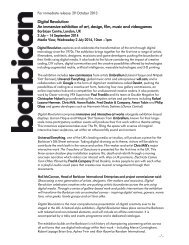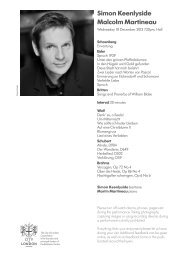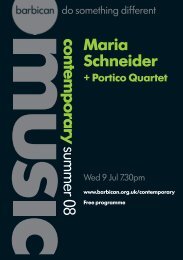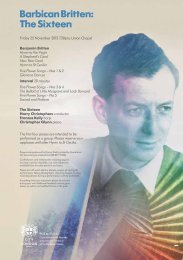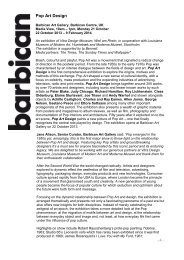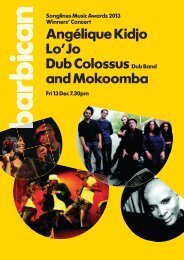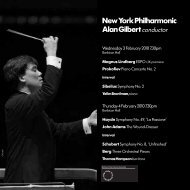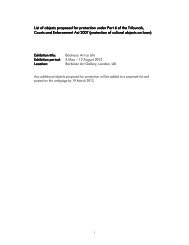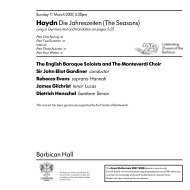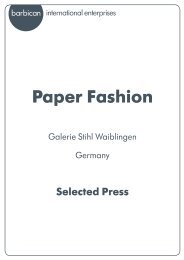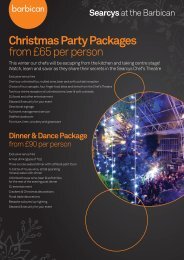Les Arts Florissants - Barbican
Les Arts Florissants - Barbican
Les Arts Florissants - Barbican
Create successful ePaper yourself
Turn your PDF publications into a flip-book with our unique Google optimized e-Paper software.
Pascal Gély<br />
Sunday 18 October 2009 7.30pm<br />
LSO St Luke’s<br />
<strong>Les</strong> <strong>Arts</strong> <strong>Florissants</strong><br />
Laura Claycomb soprano<br />
Kristian Bezuidenhout fortepiano<br />
Jonathan Cohen conductor<br />
Gluck Orphée et Euridice – Dance of the Furies; Dance of the<br />
Blessed Spirits<br />
Gluck Paride ed Elena – Ballet<br />
Mozart Piano Concerto No. 18, K456<br />
Interval<br />
Haydn Symphony No. 80<br />
Mozart Arias for soprano and orchestra:<br />
Idomeneo – Quando avran fine omai … Padre, germani,<br />
addio<br />
Vorrei spiegarvi, oh Dio<br />
Ah! se in ciel, benigne stelle<br />
These concerts are part of a series of programmes<br />
between London and Paris co-produced by the <strong>Barbican</strong><br />
Centre, the Salle Pleyel and the Cité de la Musique on the<br />
occasion of the 30th anniversary of <strong>Les</strong> <strong>Arts</strong> <strong>Florissants</strong>.
introduction<br />
<strong>Les</strong> <strong>Arts</strong> <strong>Florissants</strong> at 30<br />
What a difference a generation makes. In the past 30 years, the world of Baroque music-making has been transformed.<br />
Musicians had for a while been acquiring the skills of playing old instruments and rediscovering former playing styles, but it<br />
was only during the 1970s that these made a major impact on the wider public. Of course there had been pioneers before<br />
this: a whole generation of enthusiasts and researchers had explored old repertory, and Arnold Dolmetsch had played his<br />
clavichord in candlelit London drawing rooms to the delight of George Bernard Shaw and Percy Grainger. But this was<br />
essentially an esoteric activity – until a new generation of players and conductors launched themselves into the re-creation of<br />
Baroque ensembles in the 1970s.<br />
William Christie’s achievement with his French group <strong>Les</strong> <strong>Arts</strong> <strong>Florissants</strong> from 1979 onwards has been an outstanding part of<br />
this revival, for it grew out of a repertory that many had thought inaccessible – the distant world of the French Baroque, with<br />
its rich and dense texts, its complex ornamentation and rhetoric, and its unfamiliar emotional language. What Christie and<br />
his young ensemble achieved in spectacular fashion was to show how, when performed with penetrating understanding and<br />
vivid communication, this music could be made as available and exciting as any on offer. From Charpentier (who gave the<br />
ensemble its name) and Lully through to Rameau, <strong>Les</strong> <strong>Arts</strong> <strong>Florissants</strong> lit up this music and brought it to life with unparalleled<br />
success.<br />
Christie’s ensemble has moved from the French Baroque into Handel and Purcell, Monteverdi and Landi, and beyond that to<br />
Haydn and Mozart. It has gained a huge following for its fresh insights into Haydn’s The Creation and Monteverdi’s Vespers,<br />
and its staged operas here at the <strong>Barbican</strong> – the fantastical, video-dominated production of Rameau’s <strong>Les</strong> Paladins and Luc<br />
Bondy’s severely intense staging of Handel’s Hercules – have been among the highlights of our output.<br />
So it is appropriate that this anniversary season celebrates the historic achievement of <strong>Les</strong> <strong>Arts</strong> <strong>Florissants</strong> with opera<br />
(Purcell’s immortal Dido and Aeneas), oratorio (Handel’s rarely performed Susanna) and the French choral motets that the<br />
group has made its own. And it is also entirely typical of its work with younger artists that for two of these anniversary<br />
concerts, William Christie hands the baton on to directors of the next generation, Jonathan Cohen and Paul Agnew. Like the<br />
great music of the past, <strong>Les</strong> <strong>Arts</strong> <strong>Florissants</strong> will continue to reinvent itself as it looks towards the next 30 years.<br />
Nicholas Kenyon<br />
Managing Director<br />
2
<strong>Les</strong> <strong>Arts</strong> <strong>Florissants</strong><br />
30th Anniversary<br />
Celebration<br />
William Christie and his ensemble present<br />
an exciting and diverse musical showcase<br />
celebrating their 30th anniversary<br />
Sun 18 Oct 09 7.30pm<br />
LSO St Luke’s<br />
Jonathan Cohen conducts<br />
Haydn’s Symphony No 80 and<br />
music by Mozart and Gluck.<br />
Returns only<br />
Sun 25 Oct 09 7pm<br />
A performance of Handel’s<br />
rarely-heard oratorio Susanna<br />
with soloists including William<br />
Burden, Alan Ewing and<br />
Sophie Karthäuser.<br />
Sun 8 Nov 09 7.30pm<br />
Union Chapel<br />
Talented British conductor and<br />
tenor Paul Agnew leads this<br />
performance of Monteverdi’s<br />
Sixth Book of Madrigals.<br />
Thu 26 Nov 09 7.30pm<br />
Grand Motets by Lully, Rameau,<br />
Desmarest and Campra with<br />
soloists including Patricia<br />
Petibon and Toby Spence.<br />
Watch video interviews and listen to music clips<br />
at www.greatperformers.org.uk<br />
Box Office 0845 120 7557<br />
The <strong>Barbican</strong> is<br />
provided by the<br />
City of London<br />
Corporation
programme note<br />
Christoph Willibald Gluck (1714–87)<br />
Orphée et Euridice (1774)<br />
Dance of the Furies; Dance of the Blessed Spirits<br />
Elena ed Paride (1770)<br />
Ballet<br />
When the Emperor Francis I and his retinue heard Gluck’s<br />
Orfeo ed Euridice in Vienna’s Burgtheater on 5 October<br />
1762 they were doubtless expecting a lightweight pastoral<br />
entertainment. The occasion – the Emperor’s name-day –<br />
and the opera’s billing as an azione teatrale (‘theatrical<br />
action’) promised as much. What they got was a work of<br />
startling originality and emotional power that integrated<br />
chorus, soloists and ballet in dramatic complexes and broke<br />
down the clear-cut division between recitative and aria.<br />
Gluck’s librettist Ranieri de’ Calzabigi was a disciple of the<br />
French Enlightenment, and a passionate opponent of the<br />
artifices and excesses of Italian opera, as was the composer.<br />
Calzabigi took the archetypal myth of Orpheus’s descent to<br />
Hades to rescue Euridice and pared it down to essentials;<br />
Gluck’s music was correspondingly strong and direct, shorn<br />
of rococo frills and fripperies. The composer’s watchwords<br />
were dramatic truth and ‘beautiful simplicity’: no more<br />
pandering to the whims of overindulged and overpaid star<br />
singers. From the solemn opening chorus onwards, his music<br />
makes its effect with swift, shattering economy.<br />
In 1774 Gluck revised and expanded Orfeo as Orphée et<br />
Euridice, adding new arias and ballet numbers, including<br />
the ‘Dance of the Furies’, for dance-mad Paris, but diffusing<br />
the elemental force of the original. In Vienna the hero – part<br />
symbolic demigod, part human lover – had been sung by the<br />
castrato Gaetano Guadagni. The French deemed castratos<br />
an offence against nature, so Gluck duly reworked the role<br />
for the celebrated haute-contre (high tenor) Joseph Legros,<br />
in the process making Orpheus a more heroic figure.<br />
In the first scene of Act 2, Orpheus has subdued the Furies<br />
with the eloquence of his singing. After he has passed<br />
4<br />
through the gates of Hades, they revert to their true nature in<br />
a thrilling, torrential D minor dance. An inveterate recycler,<br />
Gluck lifted this ‘Air de Furies’ from his 1761 ballet Don Juan.<br />
It became one of his most famous movements, and a crucial<br />
influence on the Sturm und Drang (‘Storm and Stress’)<br />
symphonies of Haydn, Mozart and others. Stygian darkness<br />
yields to the pure, dazzling light of the Elysian Fields in the<br />
‘Dance of the Blessed Spirits’, an F major minuet of unearthly<br />
serenity. For Paris Gluck added, as a central trio, a sinuous<br />
D minor flute solo that leaves an aftertaste of sadness.<br />
A flop at its Viennese premiere in 1770, Gluck’s third socalled<br />
‘reform’ opera, Paride ed Elena, has always<br />
remained in the shadows. Where its predecessors, Orfeo<br />
and Alceste, are dramas of life and death, Paride ed Elena<br />
deals with Paris’s wooing of Helen. Cupid pulls the strings,<br />
while Athene appears as a malign dea ex machina with a<br />
prophecy of future carnage, which the lovers then blithely<br />
disregard. Paride ed Elena is even more static than Alceste,<br />
and suffers from having an all-soprano cast – prime reasons<br />
for its neglect. But much of the music is glorious. Variety<br />
comes from Gluck’s portrayal of the two national characters,<br />
Sparta and Troy. The Trojan Paris sings music in Gluck’s most<br />
ravishing vein, while Helen, far from being the sex-kitten of<br />
popular myth, maintains a certain Spartan aloofness until<br />
her final capitulation.<br />
Gluck magnified these national contrasts in the opera’s<br />
splendid choruses and ballet music. In the five-movement<br />
ballet sequence in Act 1, three brusque, angular dances for<br />
the Spartans alternate with two beguiling numbers for the<br />
Trojans: a gavotte that Gluck later recycled for the French<br />
version of Orfeo, and a dulcet minuet – something of a<br />
Gluck speciality.
Wolfgang Amadeus Mozart (1756–91)<br />
Piano Concerto No. 18 in B flat major, K456 (1784)<br />
1 Allegro vivace<br />
2 Andante un poco sostenuto<br />
3 Allegro vivace<br />
Kristian Bezuidenhout fortepiano<br />
When Mozart departed the service of the hated Archbishop<br />
Colloredo of Salzburg in 1781, helped by history’s most<br />
famous kick up the backside, he was confident that fame<br />
and fortune in Vienna were his for the taking. For the next<br />
few years he was triumphantly vindicated in what he dubbed<br />
‘the land of the clavier’, earning a handsome living from<br />
teaching, publishing his works and giving concerts. Though<br />
Mozart spent almost as fast as he earned, he was for a time,<br />
at least, a shrewd business operator; and he promoted<br />
himself as both performer and composer in the magnificent<br />
series of piano concertos he premiered at his own<br />
subscription concerts, held during Lent and Advent and<br />
attended by the Viennese social and musical elite.<br />
Mozart entered the B flat Concerto, K456, in his thematic<br />
catalogue on 30 September 1784. While the evidence is not<br />
watertight, he seems to have intended the work not only for<br />
his own use but also for the blind pianist Maria Theresia<br />
Paradies to perform in Paris. Mozart probably introduced<br />
the concerto to the Viennese at a Lenten subscription concert<br />
on 13 February 1785. Three days later Leopold Mozart,<br />
visiting his son and daughter-in-law in their apartment in the<br />
most fashionable quarter of Vienna, described the event to<br />
his daughter Nannerl: ‘Your brother played a glorious<br />
concerto … I had the great pleasure of hearing all the<br />
interplay of the instruments so clearly that tears of sheer<br />
delight came to my eyes. When your brother left the stage the<br />
Emperor tipped his hat and called out “Bravo, Mozart!” and<br />
when he came on to play there was huge applause.’<br />
Like all Mozart’s Viennese concertos, K456 is a wonderful<br />
amalgam of keyboard virtuosity, symphonic organisation<br />
and vivid operatic characterisation. The opening Allegro<br />
programme note<br />
vivace begins with one of the composer’s favourite march<br />
gambits, though it is immediately apparent that these are toy<br />
soldiers. Mozart’s use of woodwind, as an independent<br />
group of ‘characters’, is especially piquant: and many of the<br />
movement’s playful, epigrammatic themes are fashioned as<br />
dialogues between wind and strings, and between the<br />
various members of the wind group. The diatonic chirpiness<br />
of the opening is offset by a louring chromatic passage in<br />
B flat minor, with the woodwind playing in gaunt octaves<br />
against stabbing accents from the strings. Typically, when<br />
Mozart brings back this passage in the solo exposition he<br />
makes it even more dramatic, with sweeping keyboard<br />
arpeggios.<br />
This momentary darkening of mood foreshadows the<br />
Andante second movement, a theme and five variations in<br />
Mozart’s favourite ‘pathetic’ key of G minor. The first three<br />
variations chart a gradual increase of tension; and in the<br />
third the forlorn piano entreats the implacable orchestra like<br />
some tragic operatic heroine. The fourth variation then turns<br />
to G major for a vision of pastoral innocence, coloured by<br />
luminous woodwind writing. The poignant coda equivocates<br />
between major and minor in a way it would be tempting to<br />
call Schubertian were it not equally characteristic of Mozart.<br />
Introspection is summarily banished by the finale, a<br />
boisterous 6/8 ‘hunting’ rondo whose main subject seems to<br />
mock the theme of the Andante. Midway through the<br />
movement Mozart springs the concerto’s biggest surprise,<br />
spiriting the music to an exotically remote B minor, and<br />
setting up a clash of metre, with the orchestra (first bassoon<br />
to the fore) playing in 2/4 against the soloist's 6/8 before<br />
roles are reversed.<br />
5
programme note<br />
Franz Joseph Haydn (1732–1809)<br />
Symphony No. 80 in D minor (1783–4)<br />
1 Allegro spiritoso<br />
2 Adagio<br />
3 Menuetto<br />
4 Finale: Presto<br />
During the 1780s Haydn led something of a double life as<br />
provincial Kapellmeister at the court of Prince Nicolaus<br />
Esterházy and an international celebrity whose symphonies,<br />
quartets and piano trios were in demand throughout<br />
northern Europe. Publishers in the 18th century liked to issue<br />
instrumental works in batches of three or six; and beginning<br />
with Nos 76–8 of 1782 – designed for an aborted visit to<br />
London – all Haydn’s later symphonies were written in sets<br />
for consumption beyond the Esterházy court. The triptych<br />
Nos 79–81 from 1783–4, published more or less<br />
simultaneously in Vienna, Paris and London, proved even<br />
more popular than the 1782 symphonies. With his by now<br />
shrewdly developed commercial sense, Haydn secured<br />
additional profit from sales to publishers in Lyon and Berlin,<br />
and, true to form, sold ‘exclusive’ manuscript copies to<br />
several patrons in Austria and Germany. Two of the<br />
symphonies (we do not know which) were performed at<br />
a concert of the Viennese Tonkünstler-Societät in March<br />
1785, in a programme that also included Mozart’s cantata<br />
Davide penitente.<br />
In sets of three or six symphonies and quartets it was<br />
customary to include one work in the minor key: Haydn’s No.<br />
83, ‘La poule’ in the Paris set (1785–6), and Mozart’s G minor<br />
Symphony No. 40 are cases in point. Whereas the flanking<br />
major-key symphonies of the 1783–4 triptych, Nos 79 and 81,<br />
are essentially popular in tone, the tensions inherent in the<br />
minor mode make No. 80 a more expressively complex work.<br />
No Haydn symphony movement juxtaposes the vehement<br />
and the flippant as disconcertingly as the opening Allegro<br />
spiritoso. For most of its course the exposition lives up to the<br />
expectations aroused by the turbulent opening theme,<br />
ground out by cellos and basses against frenzied violin<br />
6<br />
tremolos. Then, at the last moment, Haydn introduces a<br />
comically trivial Ländler tune that, but for its irregular<br />
phrasing (four plus three bars), could have drifted in from a<br />
Viennese beer garden. Despite a ferocious burst of activity<br />
from the main theme, the Ländler dominates the<br />
development, turning up in various remote keys (starting with<br />
D flat major) separated by quizzical silences. The<br />
recapitulation, as usual in late Haydn, radically reworks the<br />
events of the exposition, varying and developing the main<br />
theme before plunging to D major and giving the Ländler the<br />
last word, its phrasing now ‘normalised’ into four plus four<br />
bars. In the process a movement that had begun in strenuous<br />
Sturm und Drang mode ends in the utmost levity: just the kind<br />
of thing that offended po-faced North German critics during<br />
Haydn’s lifetime.<br />
The sonata-form Adagio, in B flat, also lives on extreme<br />
contrasts. Its serene, gracious opening melody is ruffled by<br />
an agitated tutti, with swirling sextuplets in second violins and<br />
violas. The development, beginning with the main theme in<br />
B flat minor and reaching an impassioned climax in G minor,<br />
rises to a higher pitch of dramatic intensity than any previous<br />
Haydn symphony slow movement. Back in D minor, the stern<br />
minuet (whose stalking theme distantly recalls the symphony’s<br />
opening) encloses a beautiful D major trio that sets an<br />
ancient Gregorian chant against a restless, chromatically<br />
inflected accompaniment. If the two middle movements are<br />
wholly serious, Haydn the humorist takes immediate control<br />
in the scintillating, quixotic finale. The syncopated opening,<br />
fashioned so that we do not initially hear it as syncopated, is<br />
one of the composer’s best rhythmic jokes.<br />
Programme notes © Richard Wigmore
Wolfgang Amadeus Mozart<br />
Arias<br />
Idomeneo, K366 (1781) – Quando avran fine omai … Padre, germani, addio!<br />
Vorrei spiegarvi, oh Dio, K418 (1783)<br />
Ah! se in ciel, benigne stelle, K538 (1788)<br />
Laura Claycomb soprano<br />
Mozart retained a love for the female voice throughout his<br />
life, often transferring his affections for the vocal qualities of<br />
his sopranos and mezzos to affairs of the heart – real or<br />
imaginary. The three Mozart arias we hear tonight were<br />
inspired by two very particular voices. In Idomeneo, his first<br />
great opera seria, the part of Ilia (a Trojan princess,<br />
imprisoned by Idomeneo, the King of Crete, and in love with<br />
Idomeneo’s son, Idamante) was written for Dorothea<br />
Wendling, half of a renowned sisterly singing duo (Elisabeth<br />
Wendling took the role of Elettra in the same work). Mozart<br />
had written other vocal pieces for them but this was the first<br />
opportunity to write at length. The recitative and aria,<br />
‘Quando avran fine omai … Padre, gemani, addio!’, is<br />
dramatically positioned straight after the fraught overture, so<br />
it’s the very first vocal utterance we hear and it immediately<br />
sets the tone – of the torment Ilia is suffering (and the evident<br />
virtuosity of Dorothea Wendling), in a recitative that concisely<br />
brings us up to speed with the background to the story,<br />
combining storytelling with high emotion, the music echoing<br />
the twists and turns as hate and love are portrayed. The<br />
anxiety of the recitative turns to sad resolution in the aria, as<br />
Ilia faces up to that eternal conflict (just think of Dido and<br />
Aeneas), between heart and head, love for an individual and<br />
loyalty to one’s family. It’s hardly surprising that Dorothea<br />
pronounced herself very happy with the role.<br />
programme note<br />
The voice behind the aria ‘Vorrei spiegarvi, oh Dio!’ was that<br />
of Aloysia Weber, with whose family Mozart had lodged in<br />
1778 and to whom he had declared his love. Unfortunately it<br />
was not reciprocated (she married the painter and actor<br />
Joseph Lange in 1780, while Mozart subsequently married<br />
her younger sister, Constanze). The aria was one of two he<br />
wrote for Aloysia for a revival of the deservedly forgotten<br />
opera Il curioso indiscreto (which translates roughly as ‘The<br />
nosy parker’), by Pasquale Anfossi. By all accounts, the revival<br />
was a flop with the exception of Mozart’s contributions. He<br />
audibly plays to Aloysia’s strengths: a brilliant upper register,<br />
delicacy of ornamentation and the ability to sustain a musical<br />
line, all qualities that contribute to the characterisation of<br />
Clorinda who, denying her love for the Count, implores him<br />
to return to Emilia – her rival for his affections.<br />
Laura Claycomb’s final vocal offering this evening, ‘Ah! se in<br />
ciel, benigne stelle’, was also originally intended for Aloysia<br />
Lange (née Weber) and sets words by the Italian poet and<br />
librettist Metastasio (1698–1782), whose texts Mozart drew on<br />
throughout his life. The extended nature of the aria – the tone<br />
set by a far from inconsequential orchestral tutti – and its<br />
stratospheric and agile vocal writing, coupled with its<br />
heartwrending sentiments, once again bear testimony to<br />
Aloysia’s prodigious talents, and must surely have brought<br />
the house down when she premiered it in1788.<br />
Programme note © Sharona Volcano<br />
7
text and translation<br />
Quando avran fine omai … Padre, germani, addio!<br />
Recitative<br />
Quando avran fine omai l’aspre sventure mie?<br />
Ilia infelice! Di tempesta crudel misero avanzo,<br />
del genitor e de’ germani priva,<br />
del barbaro nemico misto col sangue<br />
il sangue vittime generose,<br />
a qual sorte più rea ti riserbano i Numi? …<br />
Pur vendicaste voi di Priamo<br />
e di Troia i danni e l’onte?<br />
Perì la flotta Argiva,<br />
e Idomeneo pasto forse sarà d’orca vorace …<br />
ma che mi giova, oh ciel!<br />
se al primo aspetto di quel prode Idamante,<br />
che all’onde mi rapì, l’odio deposi,<br />
e pria fu schiavo il cor,<br />
che m’accorgessi d’essere prigioniera.<br />
Ah qual contrasto, oh Dio!<br />
d’opposti affetti mi destate nel sen odio, ed amore!<br />
Vendetta deggio a chi mi dié la vita,<br />
gratitudine a chi vita mi rende …<br />
oh Ilia! oh genitor! oh prence! oh sorte!<br />
oh vita sventurata! oh dolce morte!<br />
Ma che? m’ama Idamante? …<br />
ah no; l’ingrato per Elettra sospira,<br />
e quell’Elettra meschina principessa, esule d’Argo,<br />
d’Oreste alle sciagure a queste arene fuggitiva,<br />
raminga, è mia rivale.<br />
Quanti mi siete intorno carnefici spietati? …<br />
orsù sbranate vendetta, gelosia, odio,<br />
ed amore sbranate sì quest’infelice core!<br />
Aria<br />
Padre, germani, addio!<br />
Voi foste, io vi perdei.<br />
Grecia, cagion tu sei.<br />
E un greco adorerò?<br />
8<br />
When will my bitter misfortunes be ended?<br />
Unhappy Ilia, wretched survivor of a dreadful tempest,<br />
bereft of father and brothers,<br />
the victims’ blood spilt and mingled<br />
with the blood of their savage foes,<br />
for what harsher fate have the gods preserved you?<br />
Are the loss and shame<br />
of Priam and Troy avenged?<br />
The Greek fleet is destroyed<br />
and Idomeneo perhaps will be a meal for hungry fish …<br />
But what comfort is that to me, ye heavens,<br />
if at the first sight of that valiant Idamante,<br />
who snatched me from the waves, I forgot my hatred,<br />
and my heart was enslaved<br />
before I realised I was a prisoner.<br />
O God, what a conflict of warring emotions<br />
you rouse in my breast, hate and love!<br />
I owe vengeance to him who gave me life,<br />
gratitude to him who restored it …<br />
O Ilia! O father, O prince, O destiny!<br />
O ill-fated life, O sweet death!<br />
But yet does Idamante love me?<br />
Ah no; ungratefully he sighs for Electra;<br />
and that Electra, unhappy princess, an exile from Argos<br />
and the torments of Oresetes, who fled,<br />
a wanderer, to these shores, is my rival.<br />
Ruthless butchers, how many of you surround me? …<br />
Then up and shatter, vengeance,<br />
jealousy, hate and love; yes, shatter my unhappy heart!<br />
Father, brothers, farewell!<br />
You are no more; I have lost you.<br />
Greece, you are the cause;<br />
and shall I love a Greek?
D’ingrata al sangue mio<br />
So che la colpa avrei;<br />
Ma quel sembiante, oh Dei!<br />
Odiare ancor non so.<br />
Padre, germani, addio, etc.<br />
Vorrei spiegarvi, oh Dio!<br />
Vorrei spiegarvi, oh Dio!<br />
Qual è l’affanno mio;<br />
Ma mi condanna il fato<br />
A piangere e tacer.<br />
Arder non può il mio core<br />
Per chi vorrebbe amore<br />
E fa che cruda io sembri,<br />
Un barbaro dover.<br />
Ah conte, partite, correte,<br />
Fuggite, lontano da me.<br />
La vostra diletta Emilia v’aspetta,<br />
Languir non la fate,<br />
È degna d’amor.<br />
Ah stelle spietate!<br />
Nemiche mi siete.<br />
Mi perdo s’ei resta, oh Dio, Mi perdo.<br />
Ah, conte, partite …<br />
Partite, correte, d’amor non parlate,<br />
È vostro il suo cor.<br />
Ah se in ciel, benigne stelle<br />
Ah se in ciel, benigne stelle,<br />
La pietà non è smarrita,<br />
O toglietemi la vita,<br />
O lasciatemi il mio ben.<br />
Voi, che ardete ognor sì belle<br />
Del mio ben nel dolce aspetto,<br />
Proteggete il puro affetto<br />
Che inspirate a questo sen.<br />
I know that I am guilty<br />
of abandoning my kin;<br />
but I cannot bring myself,<br />
O gods, to hate that face.<br />
Father, brothers, farewell, etc.<br />
I would like to explain to you, oh God,<br />
how great is my anguish!<br />
Fate, however, condemns me<br />
to weep and keep silent.<br />
My heart cannot burn<br />
for him who would desire love<br />
and a pitiless duty<br />
makes me appear cruel.<br />
Alas, Count, part from me, hurry,<br />
flee far from me.<br />
Your beloved Emilia awaits you,<br />
don’t keep her languishing,<br />
she is worthy of love.<br />
Alas, pitiless stars!<br />
You are hostile to me.<br />
I am lost if he remains, oh God! I am lost.<br />
Ah, Count, part from me.<br />
Part from me, hurry, do not talk of love,<br />
her heart is yours.<br />
Ah, kind stars, if Heaven<br />
has not abandoned mercy,<br />
then take my life from me,<br />
or let me keep my beloved.<br />
You, who always shine so brightly<br />
on my darling’s sweet face,<br />
protect the pure affection<br />
which you inspire in that heart.<br />
text and translation<br />
9
Pascal Gély<br />
about the performers<br />
About tonight’s performers<br />
Jonathan Cohen conductor<br />
Jonathan Cohen was born in<br />
Manchester in 1977. In demand as a<br />
cellist, conductor and keyboard player,<br />
his repertoire ranges from the Baroque<br />
to contemporary music.<br />
He began his solo career as a cellist,<br />
performing with the Orchestra of the<br />
Age of Enlightenment, Philharmonia<br />
Orchestra, Scottish Chamber<br />
Orchestra and The King’s Consort,<br />
and today he continues to give<br />
concerts as a cellist with the London<br />
Haydn Quartet.<br />
In recent years Jonathan Cohen has<br />
turned increasingly to conducting,<br />
studying with Nicholas Kraemer and<br />
Vladimir Jurowski and specialising in<br />
the Baroque and Classical repertoires.<br />
Building on his experience of early<br />
music (which goes back to his student<br />
10<br />
Laurence Mullenders<br />
years in Cambridge), he conducted 10<br />
performances of The Fairy Queen at<br />
the Théâtre d’Aix-la-Chapelle in 2006.<br />
He regularly assists William Christie<br />
(Idomeneo, The Creation, Rameau’s<br />
<strong>Les</strong> Paladins and Handel’s L’Allegro, il<br />
Penseroso ed il Moderato) and since<br />
2008 he has shared the conducting of<br />
several productions with him, notably<br />
Hérold’s Zampa and Purcell’s The<br />
Fairy Queen. He is also in regular<br />
demand as assistant conductor to<br />
Emmanuelle Haïm.<br />
This season Jonathan Cohen conducts<br />
<strong>Les</strong> <strong>Arts</strong> <strong>Florissants</strong> in Dido and<br />
Aeneas, Actéon and The Fairy Queen<br />
in Amsterdam, Paris and New York.<br />
Laura Claycomb soprano<br />
Native Texan Laura Claycomb, known<br />
for her delicacy, refinement and<br />
theatricality in high-flying repertoire, is<br />
one of the world’s foremost lyric<br />
coloraturas. Following concurrent<br />
degrees in Music and Foreign<br />
Languages at Southern Methodist<br />
University and a subsequent<br />
apprenticeship with San Francisco<br />
Opera, she made her European debut<br />
as Giulietta (I Capuleti e I Montecchi) in<br />
Geneva, reprising it in Paris, Los<br />
Angeles and Munich. She has<br />
subsequently garnered acclaim as<br />
Gilda (Rigoletto) in Houston, Toronto,<br />
Paris, Lausanne, Tel Aviv, Santiago de<br />
Chile and Bilbao; Cleopatra (Giulio<br />
Cesare) in Houston, Drottningholm<br />
and Montpellier; and the title-roles of<br />
Lucia di Lammermoor in Houston, Tel<br />
Aviv, Seoul and Moscow, and La Fille<br />
du Régiment in San Francisco, Turin,<br />
Houston and Rome. Other signature<br />
roles include Linda di Chamounix,<br />
Zerbinetta (Ariadne auf Naxos), Anne<br />
Trulove (The Rake’s Progress), Amanda<br />
(Ligeti’s Le Grand Macabre),<br />
Morgana (Alcina), Adèle (Le comte<br />
Ory), Ophélie (Thomas’s Hamlet) and<br />
the creation of Queen Wealtheow in<br />
Elliot Goldenthal’s Grendel.<br />
She also regularly performs in concert<br />
with leading conductors and<br />
orchestras.
Fourth Symphony with Michael Tilson<br />
Thomas and the San Francisco<br />
Symphony, Le Grand Macabre under<br />
Esa-Pekka Salonen, a disc of Handel<br />
duets directed by Emmanuelle Haïm,<br />
Vaughan Williams’s Sir John in Love<br />
with Richard Hickox, two recordings<br />
of Berlioz’s Benvenuto Cellini, under<br />
Sir Roger Norrington and Sir Colin<br />
Davis, and recordings of lesser-known<br />
operas by Meyerbeer, Balfe, Pacini<br />
and Thomas.<br />
Marco Borggreve Her recordings include Mahler’s<br />
Kristian Bezuidenhout fortepiano<br />
Kristian Bezuidenhout was born in<br />
South Africa in 1979 and his teachers<br />
included Malcolm Bilson, Paul O’Dette<br />
and Robert Levin. He won First Prize<br />
and the Audience Prize in the 2001<br />
Bruges Fortepiano Competition.<br />
He regularly performs on fortepiano,<br />
harpsichord and modern piano in<br />
North America, Europe, Australia and<br />
Asia. Among the festivals at which he<br />
has appeared are those of Barcelona,<br />
Boston, Bruges, Esterhaza, Utrecht, St<br />
Petersburg, Vermont, Venice and West<br />
Cork. He is currently professor of the<br />
Eastman School of Music and in Basle.<br />
His recordings include solo fortepiano<br />
works and violin sonatas by Mozart,<br />
Schubert’s Die schöne Müllerin, and<br />
Bach concertos with Daniel Hope.<br />
Highlights of last season include a tour<br />
with Frans Brüggen and the Orchestra<br />
of the 18th Century, performing<br />
Mozart’s late piano concertos. This<br />
season he plays concertos with the<br />
Freiburg Baroque Orchestra, goes on<br />
tour with the Royal Concertgebouw<br />
Orchestra, conducted by Ton<br />
Koopman, performs and records<br />
Schumann’s Dichterliebe with Mark<br />
Padmore and takes part in the 2010<br />
Holland Festival, where he will be<br />
playing from Bach’s 48.<br />
<strong>Les</strong> <strong>Arts</strong> <strong>Florissants</strong><br />
about the performers<br />
The renowned vocal and instrumental<br />
ensemble <strong>Les</strong> <strong>Arts</strong> <strong>Florissants</strong> was<br />
founded in 1979 by William Christie,<br />
and takes its name from an opera by<br />
Marc-Antoine Charpentier.<br />
Since the acclaimed production of Atys<br />
by Lully at the Opéra Comique in Paris<br />
in 1987, it has been in the field of opera<br />
where <strong>Les</strong> <strong>Arts</strong> <strong>Florissants</strong> has found<br />
most success. Notable productions<br />
include works by Rameau (<strong>Les</strong> Indes<br />
galantes in 1990 and 1999, Hippolyte<br />
et Aricie in 1996, <strong>Les</strong> Boréades in 2003,<br />
<strong>Les</strong> Paladins in 2004), Charpentier<br />
(Médée in 1993 and 1994), Handel<br />
(Orlando in 1993, Acis and Galatea in<br />
1996, Semele in 1996, Alcina in 1999,<br />
Hercules in 2004 and 2006), Purcell<br />
(King Arthur in 1995, Dido and Aeneas<br />
in 2006), Mozart (The Magic Flute in<br />
1994, Die Entführung aus dem Serail at<br />
the Opéra du Rhin in 1995) and<br />
Monteverdi (Il ritorno d’Ulisse in patria<br />
at Aix-en-Provence in 2000, revived in<br />
2002, L’incoronazione di Poppaea in<br />
2005, and L’Orfeo at the Teatro Real<br />
de Madrid in 2008).<br />
<strong>Les</strong> <strong>Arts</strong> <strong>Florissants</strong> has an equally high<br />
profile in the concert hall, giving<br />
concert performances of operas<br />
(Zoroastre and <strong>Les</strong> fêtes d’Hébé by<br />
11
about the performers & player list<br />
Rameau, Idomenée by Campra,<br />
Jephté by Montéclair and L’Orfeo by<br />
Rossi), as well as secular chamber<br />
works (Actéon, <strong>Les</strong> plaisirs de<br />
Versailles and La descente d’Orphée<br />
aux Enfers by Charpentier and Dido<br />
and Aeneas by Purcell) and sacred<br />
music (grands motets by Rameau,<br />
Mondonville and Desmarest) and<br />
Handel oratorios.<br />
The ensemble has an impressive<br />
discography of over 70 CD recordings,<br />
most recently Haydn’s The Creation. Its<br />
most recent DVD is Il Sant’Alessio by<br />
Stefano Landi, filmed at the Théâtre de<br />
Caen, where, for the past 15 years, the<br />
ensemble has been artist-in-residence.<br />
<strong>Les</strong> <strong>Arts</strong> <strong>Florissants</strong> also tours widely<br />
within France, and is a frequent<br />
ambassador for French culture<br />
abroad, regularly appearing at the<br />
Brooklyn Academy, the Lincoln Center<br />
in New York, the <strong>Barbican</strong> Centre and<br />
the Vienna Festival.<br />
<strong>Les</strong> <strong>Arts</strong> <strong>Florissants</strong> receive financial<br />
support from the Ministry of Culture and<br />
Communication, the City of Caen and the<br />
Région Basse-Normandie. Their sponsor is<br />
Imerys. <strong>Les</strong> <strong>Arts</strong> <strong>Florissants</strong> are artists in<br />
residence at the Théâtre de Caen.<br />
12<br />
<strong>Les</strong> <strong>Arts</strong> <strong>Florissants</strong><br />
Musical Director<br />
William Christie<br />
Executive Manager<br />
Luc Bouniol-Laffont<br />
Tonight’s Conductor<br />
Jonathan Cohen<br />
Orchestra<br />
Violin I<br />
Nadja Zwiener leader<br />
Bernadette Charbonnier<br />
Martha Moore<br />
Benjamin Scherer<br />
Satomi Watanabe<br />
Violin II<br />
Catherine Girard<br />
Sophie Gevers-Demoures<br />
Michèle Sauvé<br />
George Willms<br />
Viola<br />
Galina Zinchenko<br />
Lucia Peralta<br />
Jean-Luc Thonnerieux<br />
Cello<br />
David Simpson<br />
Damien Launay<br />
Alix Verzier<br />
Double Bass<br />
Jonathan Cable<br />
Joseph Carver<br />
Flute<br />
Charles Zebley<br />
Serge Saitta<br />
Oboe<br />
Pier Luigi Fabretti<br />
Michel Henry<br />
Bassoon<br />
Claude Wassmer<br />
Philippe Piat<br />
Horn<br />
Helen MacDougall<br />
Benjamin Locher




